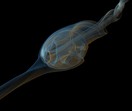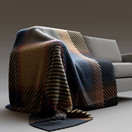Winners
The Computer Graphics Forum 2011 Cover Image has been selected by the CGF editorial board. We thanks all people who submitted this year, and hope that they will participate to the next year contest.
Winner of the Computer Graphics Forum 2011 Cover Image Contest

Mathias Hummel (1), Christoph Garth (2), Bernd Hamann (2), Hans Hagen (1) and Kenneth I. Joy (2)
(1) University of Kaiserslautern
(2) University of California, Davis
The image shows a stream surface in a vortex breakdown bubble. It was created using IRIS, our system for illustrative surface rendering.
Integral surfaces are ideal tools to illustrate vector fields and fluid flow structures. However, these surfaces can be visually complex and exhibit difficult geometric properties, owing to strong stretching, shearing and folding of the flow from which they are derived. To address these problems, we presented IRIS, an interactive rendering pipeline that uses illustrative methods specifically adapted to the properties of integral surfaces.
In the image, IRIS reveals inner structures of the surface by locally adapting the opacity based on a curvature estimation. The two sides of the surface are colored differently to help the viewer understand how the surface behaves.
Second place:

Marcos Slomp (1), Shota Kanamori (1) and Kazufumi Kaneda (2)
(1) Graduate School of Engineering, Hiroshima University, Japan
(2) Faculty of Engineering, Hiroshima University, Japan
Fantastic Rainy Scene
Raindrops are rendered using a texture-based approach [Slomp et al. 2010], each treated as a point-sprite whose size varies based on the distance from the camera. Each produced fragment samples over a preprocessed reflective and refractive hierarchical map, retrieving canonical reflection and refraction vectors, along with Fresnel coefficient and multi-sampled transparency. Non-transparent fragments will have their sampled reflected and refracted vectors further transformed by a rotation matrix - derived based on the raindrop's attitude relative to the canonical camera used to preprocess the hierarchical maps - which then sample an environment map. The final color contribution is determined after proper modulation with the Fresnel coefficient.
The rainbow mask is rendered by using a ray casting method during preprocessing. The method accounts for wave optics and the distribution of raindrops [Kanamori et al. 2010]. These efforts enable the method to render the visual variations of the three types of rainbows: the primary and the secondary rainbows, and supernumerary rainbows.
A dynamically generated cube-map is rendered every frame by copying the respective cube-map faces from a selected static environment map and then composed with the rainbow mask through additive blending, all on GPU. This allow changes on the rainbow properties such as location, brightness and size without perturbing the original static cube-map. Raindrops' fragments samples from this dynamic environment map so that the rainbow is presented properly within the raindrops. The position of the raindrops are also updated every frame and done entirely on the GPU, either through transform-and-feedback buffers, or via classic render-to-texture copy-to-vertex-buffer approach [Slomp et al. 2010].
Finally, if an HDR environment map is being used, tone-mapping is performed using the Photographic Operator [Reinhard et al. 2002], thus compressing the wide luminance range of the scene into the displayable range of the device. The overall performance of the technique exceeds 70 FPS on a GeForce GTX 280 with full-screen image resolution of 1920x1200 pixels and 2 million raindrops.
St. Peter's Basilica and Eucalyptus Grove environment maps courtesy of Paul Debevec (http://www.debevec.org/Probes). Paris Bridge environment map courtesy of Industry Graphics (http://www.realtexture.com) from the LightWorks HDRI Starter Collection (http://www.lightworkdesign.com).
[Slomp et al. 2010] Marcos Slomp, Matthew Johnson, Toru Tamaki and Kazufumi Kaneda. 2010. "Photorealistic real-time rendering of spherical raindrops with hierarchical reflective and refractive maps". Proceedings of the 2010 ACM SIGGRAPH Symposium on Interactive 3D Graphics and Games (i3D 2010): Posters.
[Kanamori et al. 2010] Shota Kanamori, Kazuya Fujiwara, Takahiro Yoshinobu, Bisser Raytchev, Toru Tamaki, Kazufumi Kaneda. 2010. "Physically Based Rendering of Rainbows Under Various Atmospheric Conditions". The 18th Pacific Conference on Computer Graphics and Applications (Pacific Graphics 2010): Poster.
[Reinhard et al. 2002] Erik Reinhard, Michael Stark, Peter Shirley and James Ferwerda. 2002. "Photographic tone reproduction for digital images". Proceedings of the 29th annual conference on Computer graphics and interactive techniques (SIGGRAPH 2002).
Third place:

Kai Schröder (1), Arno Zinke (2) and Reinhard Klein (1)
(1) University of Bonn
(2) GfaR mbH
The image has been generated using a new method for the physically accurate rendering of textiles.
In contrast to existing methods which require a prohibitively costly explicit respresentation of yarn fibers, we efficiently approximate their distribution using a volumetric statistical model. Based on this compact description, Monte Carlo path tracing of large pieces of cloth becomes practical on standard consumer hardware.
